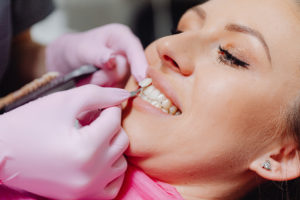 Celebrities and social media influencers always seem to have flawless smiles, but most aren’t natural. Veneers are a common secret in Hollywood for creating picture-perfect teeth. Nowadays, veneers are affordable for people from all walks of life. Although their popularity only took off within the last couple of decades, veneers aren’t a new innovation. They’ve been used for almost 100 years! Here’s how they’ve evolved throughout time to provide the stunning results of today.
Celebrities and social media influencers always seem to have flawless smiles, but most aren’t natural. Veneers are a common secret in Hollywood for creating picture-perfect teeth. Nowadays, veneers are affordable for people from all walks of life. Although their popularity only took off within the last couple of decades, veneers aren’t a new innovation. They’ve been used for almost 100 years! Here’s how they’ve evolved throughout time to provide the stunning results of today.
Development of Early Dental Veneers
Veneers were first developed in 1928 by a Californian dentist named Dr. Charles Pincus. He was tasked with changing the appearance of an actor’s smile for a film. He created a temporary solution by applying an acrylic material to the front surfaces of the actor’s teeth. They were held in place with a temporary adhesive. They were successful, but they would fall off after only 1-2 hours. As a result, Dr. Pincus had to remain onsite to reapply them throughout the shoot.
With Dr. Pincus’s services in high demand, dental professionals began trying their hand at veneers. In the 1930s and 1940s, composite materials and porcelain were used for veneers because they created more realistic results. Changing materials made veneers accessible to everyone, not just movie stars.
Veneers experienced another significant advancement in 1959. Dr. Michael Buonocore developed a revolutionary etching method that’s still used today. He found that a stronger bonding surface occurs when applying a mild acidic solution to a tooth. This opens the pores in the enamel to make veneers last longer. This etching method is commonplace in modern dentistry and can be used for various treatments, like dental sealants and fillings.
Modern-Day Dental Veneers
Dr. R.J. Simonsen and Dr. J.R. Calamia made another improvement to veneers in the 1980s after developing a new technique to etch teeth with hydrofluoric acid for an even stronger bond. The average lifespan of modern veneers is over 10 years, thanks to this etching technique.
Porcelain is the go-to solution used in today’s dentistry because it resembles enamel. Porcelain is also biocompatible to lessen the risk of any adverse complications. Veneers are also thinner than ever but more durable. Their ultra-thin design allows less enamel to be removed during the application process, making the procedure less invasive.
Invest in Long-Lasting Results
Veneers are a popular cosmetic treatment because they can fix many issues at once using a minimally invasive procedure. This saves time and money while providing results that can last for a decade or more. Veneers can give you a red carpet smile you’ll be proud of.
About Dr. Dan Maurer
Dr. Maurer earned his dental degree from the University of Colorado School of Dental Medicine. He is a lifelong learner who regularly continues his education to provide up-to-date dental solutions, including veneers. Request an appointment through his website or call (702) 552-5350.
